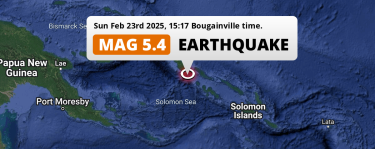Latest earthquakes near Papua New Guinea today
Complete overview of the latest earthquakes near the country Papua New Guinea, updated every minute. Did you feel an earthquake today in Papua New Guinea? If an earthquake is happening right now near Papua New Guinea (also known as Papua Niugini), it will show up within minutes.
Recent Papua New Guinea Earthquake News
These are the latest articles published related to earthquakes occurring near Papua New Guinea. Check our Earthquake News section for a complete overview of articles written on earthquakes near Papua New Guinea and elsewhere.
Papua New Guinea Earthquake Statistics
Average
A total of 7576 earthquakes with a magnitude of four or above have struck within 300 km (186 mi) of Papua New Guinea in the past 10 years. This comes down to a yearly average of 757 earthquakes per year, or 63 per month. On average an earthquake will hit near Papua New Guinea roughly every 11 hours.
A relatively large number of earthquakes occurred near Papua New Guinea in 2015. A total of 1121 earthquakes (mag 4+) were detected within 300 km of Papua New Guinea that year. The strongest had a 7.5 magnitude.

Magnitude Distribution
The table below visualizes the distribution of all earthquakes that occurred within 300km of Papua New Guinea in the past 10 years. No earthquakes with a magnitude of 8 or above have occurred near Papua New Guinea during this time. Usually, higher magnitudes are less common than lower magnitudes. Small earthquakes with a magnitude below 4 on the Richter scale have been omitted from this overview.
| Magnitude | Earthquakes | Percentage |
|---|---|---|
| Mag. 4 | 6479 | 85.52% |
| Mag. 5 | 1001 | 13.21% |
| Mag. 6 | 84 | 1.11% |
| Mag. 7 | 12 | 0.16% |
| Mag. 8 | 0 | 0.0% |
| Mag. 9 | 0 | 0.0% |
| Mag. 10 | 0 | 0.0% |
Strongest earthquakes near Papua New Guinea
The strongest recent earthquake of the past 10 years near Papua New Guinea occurred on Dec 17, 2016 20:51 local time (Pacific/Port_Moresby timezone). It had a magnitude of 7.9 and struck 140 kilometers (87 mi) east of Kokopo, at a depth of 95 km. Discover more strong earthquakes near Papua New Guinea in the list below.
A longer time ago, a MAG-8.2 earthquake struck on May 7, 1919 05:41, 184 kilometers (114 mi) east of Kokopo. It is the strongest earthquake near Papua New Guinea in the past 125 years (Our data goes back to January 1st, 1900).
In the table below you will find the strongest earthquakes that occurred near Papua New Guinea in the past 10 years. You can use the tabs to find the heaviest historic earthquakes since the year 1900 or within a specific year or distance from Papua New Guinea.
Earthquakes by region of Papua New Guinea
Click the links below for earthquake reports for regions in Papua New Guinea.
- Bougainville
- East New Britain
- East Sepik
- Eastern Highlands
- Madang
- Morobe
- National Capital
- Northern Province
- Southern Highlands
- West New Britain
- Western Highlands
- Western Province
Frequently Asked Questions
These questions are commonly asked in relation to earthquakes occurring near Papua New Guinea.
When was the last earthquake in Papua New Guinea?
A 4.4 magnitude earthquake hit near Papua New Guinea on the afternoon of March 10, 2025 at 13:17 local time (Pacific/Port_Moresby). The center of this earthquake was located 135km north-northwest of Lae at a depth of 144km under water in the Bismarck Sea. Check the list on our website for any earthquakes occurring near Papua New Guinea in the past hours.
What was the strongest earthquake near Papua New Guinea?
A 8.2 magnitude earthquake hit near Papua New Guinea on the night of May 7, 1919 at 05:41 local time (Pacific/Port_Moresby). The center of this earthquake was located 184km east-southeast of Kokopo at a depth of 35km under water in the South Pacific Ocean. This is the strongest earthquake that occurred near Papua New Guinea since the year 1900.
How often do earthquakes occur near Papua New Guinea?
In the past 10 years, 7576 earthquakes with a magnitude of four or higher occurred within a 300 kilometer range from Papua New Guinea. This averages to 758 earthquakes yearly, or one earthquake every 12 hours.

 Feb 24, 2025 09:50AM
Shallow M5.2 Earthquake hit in the Solomon Sea 120km from Arawa (Papua New Guinea) on Monday Morning.
Feb 24, 2025 09:50AM
Shallow M5.2 Earthquake hit in the Solomon Sea 120km from Arawa (Papua New Guinea) on Monday Morning.
 Feb 23, 2025 03:17PM
Significant M5.4 AFTERSHOCK hit in the Solomon Sea 132km from Arawa (Papua New Guinea) on Sunday Afternoon.
Feb 23, 2025 03:17PM
Significant M5.4 AFTERSHOCK hit in the Solomon Sea 132km from Arawa (Papua New Guinea) on Sunday Afternoon.
 Feb 23, 2025 12:31PM
Significant M5.6 Earthquake struck on Sunday Afternoon in the Solomon Sea 143km from Arawa (Papua New Guinea).
Feb 23, 2025 12:31PM
Significant M5.6 Earthquake struck on Sunday Afternoon in the Solomon Sea 143km from Arawa (Papua New Guinea).
 Feb 23, 2025 09:21AM
Significant M5.3 FORESHOCK hit in the Solomon Sea 145km from Arawa (Papua New Guinea) on Sunday Morning.
Feb 23, 2025 09:21AM
Significant M5.3 FORESHOCK hit in the Solomon Sea 145km from Arawa (Papua New Guinea) on Sunday Morning.
 Jan 25, 2025 04:26AM
Shallow M5.7 Earthquake struck on Saturday Night in the Bismarck Sea 173km from Kokopo (Papua New Guinea).
Jan 25, 2025 04:26AM
Shallow M5.7 Earthquake struck on Saturday Night in the Bismarck Sea 173km from Kokopo (Papua New Guinea).
